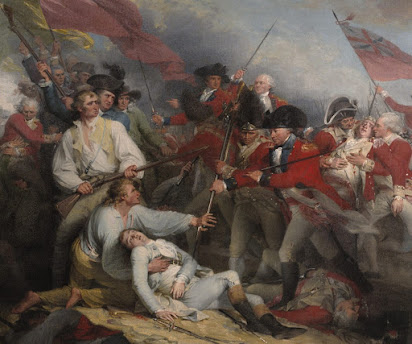Classical Blog
Revolutionary Art
During the 1700's, a lot was happening in the world. In my blog, I'm going to be focusing on the American Revolution, also known as the U.S. War of Independence. There is a lot of art from this, and I will be talking about a few paintings I find most interesting.
The Battle of Bunker’s Hill, June 17, 1775, by John Trumbull, 1786
This depicts The Battle of Bunker's Hill. This was the first major battle of the Revolutionary War, which happened a few months after the opening battles at Lexington and Concord, and also the beginning of the siege of Boston. As the patriots took up position on Breeds Hill, which overlooks Boston, the British sent three thousand men to try and take out the Americans and take the hill for themselves. The Battle of Bunker Hill was the subject of John Trumbull’s first canvas in a series of history paintings of principal events of the American Revolution.
A lot is going on in this painting, from the main focus being in the center of the painting to all the action going around in the background. There is a lot of red throughout the painting, but also a lot of beige, and shadows. A lot of emotion is depicted in this work of art, and I think that really helps bring attention to it and makes the viewer look throughout the painting.
I personally would not own a copy of this painting.
The Battle of Princeton, January 3, 1777, by James Peale, ca. 1782
This shows the Battle of Princeton. This was George Washington's first battlefield victory. This battle was accidental, to say. Both sides stumbled into one another, and neither expected to fight on the ground where the battle raged. Washington led troops onto the field while arterially was shot and forced the British back. Washington's counterattack broke the British line.
This painting has a lot of neutral colors, getting more blended together the further the focus away is. I feel like this one isn't as detailed but still tells an entire story within it. This painting feels a lot "softer" compared to the painting above.
I would not own a copy of this painting.
The Capture of Yorktown, 19 October 1781 by Louis-Nicolas van Blarenberghe, 1785.
This painting shows the surrender of the British troops in Yorktown, headed towards the surrender field in 1781. The French and American soldiers are flanking the British troops out of the town. The British troops were outnumbered and outfought during a three-week-long siege. The end of this battle marked the last major land battle of the American Revolution and led to negotiations for peace with the British and the signing of the Treaty of Paris in 1783.
A lot is also going on in this painting. The artist did a fantastic job of showing the surrender. The city of Yorktown and the York River are in the background, all the way to the troops and even flags in the troops. It has a lot of colors, with the red of the British popping out and catching the eye of the viewer.
I personally would not own a copy of this painting.
“Ten Great Revolutionary War Paintings, 1775-1790.” The American Revolution Institute, 10 Dec. 2020, www.americanrevolutioninstitute.org/treasures-of-the-american-revolution/revolutionary-war-paintings/. Accessed 18 Mar. 2024.
“Yorktown.” American Battlefield Trust, https://www.battlefields.org/learn/revolutionary-war/battles/yorktown. Accessed 18 Mar. 2024.



I chose art from the American Revolution. I also chose to include "The Capture of Yorktown" in my blog. This painting was actually painted in Britain by an artist who had never set foot in America, so it actually resembles more of a French landscape rather than an accurate depiction of the battle-torn area. This just goes to show that people in that time period were only able to paint things that they were familiar with and lacked some of the creativity that some can show today.
ReplyDeleteI like these three pieces together because compositionally the split between the bottom 2/3 and the top 1/3 is clearly defined and similar across all three. This makes them function well together as a set and perhaps is apart of the imagery of the american revolution. I also like that you pointed out the strong use of color across each piece and how it adds to the effect of each piece. I wish you had incorporate more geographic information about where these artists came from and where they painted the scenes. because all the paintings were done around the same time it makes me intrigued about the subtle differences in styles, like how you mentioned The Battle of Princeton was a bit 'softer' then the other pieces.
ReplyDeleteHey Mercedes,
ReplyDeleteI like your focus on revolutionary art! Something about the ferocity of the wars pair so well with the intrigue that the difference in time creates. Seeing an army of men in red wielding muskets at a time where the lands have yet to really be developed elicits such an odd feeling to me. The attention to detail to attire manages to create such focus on even the smaller parts of the paintings, which really breathes some life into them. I especially like "The Battle of Bunker's Hill", which I'd also chosen to cover. While I'd focused on things such as the foreground being littered with bodies, I agree with your take on how the vibrant colors juxtapose with the gritty and bland coloring of the surrounding battle to create an immersive image. I feel like this is especially true with your last painting, "The Capture of Yorktown". Thanks for sharing these paintings!